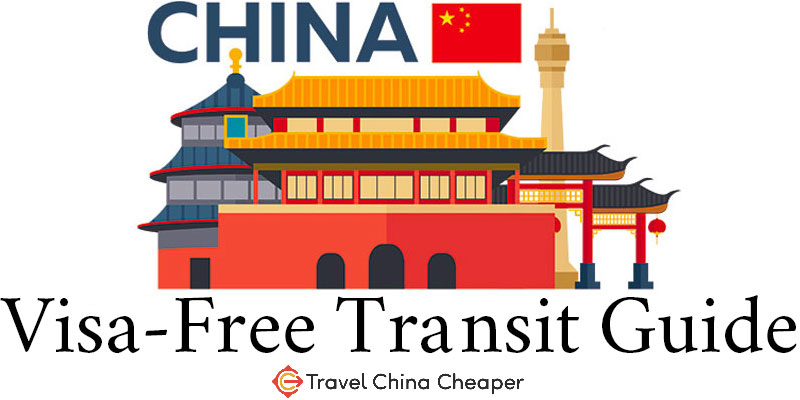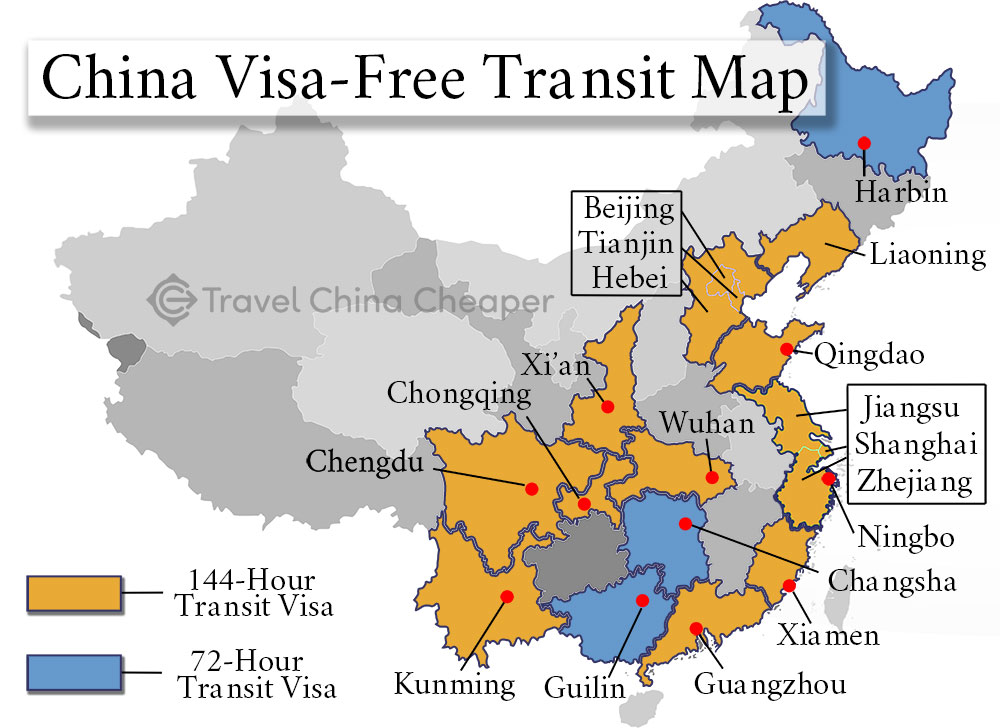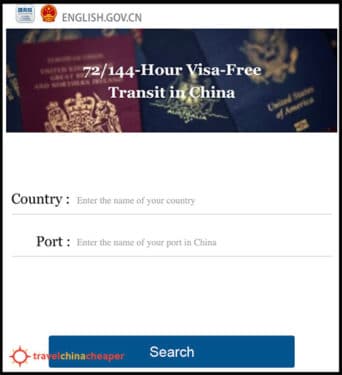For those of you who plan to transit through China, the ever-expanding China Visa-Free Transit, or what is sometimes referred to as the China Transit Visa program, is a welcome opportunity to see the country without the hassle of applying for a full visa. Here’s the most accurate, up-to-date guide for everything you need to know in 2020.

Up until recently, most travelers who wanted to spend any significant portion of time in China had to go through the process of applying for a China Visa. This not only included filling out the application, but also paying the consulate fees, waiting for approval, etc.
It’s time consuming, expensive and, honestly, not fun.
But what if you’re stopping in Beijing for just a few days of your international journey and you want to go see the Great Wall of China?
Perhaps you have a cruise that departs/arrives in Shanghai and you want to wander the city for a few days?
In both cases, the visa-free transit in China is an excellent option.
This is the ultimate guide to China’s visa-free transit, both the 72-hour visa free transit and the 144-hour visa free transit.
As you read, if you find this guide helpful, you’ll greatly benefit from the best-selling Travel to China | Everything You Need to Know Before You Go, my published guide from which this was excerpted.
**Important Note** I will no longer be answering comments on this article asking about specific itineraries.
Also, thanks to ever-evolving Chinese policies, I cannot guarantee that you will be issued a China transit visa.
Transit Visa vs Visa-Free Transit in China
You might hear this referred to as the “China transit visa” across the internet. Technically, it’s called China’s visa-free transit.
A transit visa does exist, called the G visa in China, but you must apply for this at the Chinese consulate before you arrive in China.
Unlike this G visa, entering China under the rules of the visa-free transit happens upon arrival in China. This means that you don’t need to apply before you get on the airplane, which theoretically could save you a good amount of time and money.
However, China’s visa-free transit is notoriously confusing and there are a number of restrictions that you need to understand. It’s good to gather this info before you decide to take advantage of the China transit visa, whether that be the 24-hour transit visa, the 72-hour transit visa or the 144-hour transit visa.
I’m going to do my best here to clear up the confusion by breaking down the steps you need to take.
Check Your Eligibility for the China Transit Visa
Before you read any further, you should start here. I recommend you do is to follow the link below to use a tool developed by the Chinese government to explain eligibility.
Within the tool, you’ll be asked to enter your passport country and your Chinese port of entry.
When you click “search”, it will list out which transit visa is available for you (i.e. 72-hour visa-free transit China, 144-hour visa-free transit China). It also tells you where you are allowed to travel, and where you are allowed to enter/exit.Check Transit Visa Eligibility
Which Cities Offer Visa-Free Transit in China?
It’s important to distinguish between two parts of the transit visa: your port of entry and your region of movement.
PORTS OF ENTRY
In order to take advantage of visa-free transit in China, you MUST arrive and depart directly through one of the following cities. This usually happens at an airport, but in some cases can be done through a seaport or train station.
- Beijing, Shanghai*† – 144-hour visa-free by air, sea or train;
- Tianjin*, Xiamen*, Qingdao* – 144 hour visa-free by air or sea;
- Qinhuangdao – 144-hour transit visa via sea port only;
- Guangzhou, Xian, Chongqing, Ningbo, Hangzhou, Nanjing, Shijiazhuang, Dalian, Shenyang, Kunming, Chengdu, Wuhan – 144 hour visa-free via airport only;
- Harbin, Changsha, Guilin – 72-hour visa-free service;
* Includes entry via a sea port
† Includes entry via train station
These are the air, sea and rail ports that offer China’s visa-free travel as of May 1, 2020.
REGION OF MOVEMENT
Once you’ve entered through one of these ports of entry, visitors taking advantage of the 72-hour or 144-hour transit visa in China must remain within the specified regions for each port that include:
- Beijing, Tianjin, Hebei (Qinghuangdao, Shijiazhuang): Travelers entering each of these ports here can move freely among these three regions.
- Shanghai, Jiangsu, Zhejiang: Travelers entering each of these ports may move freely within these provinces.
- Guangzhou, Chengdu, Xi’an, Kunming, Wuhan, Chongqing, Changsha, Xiamen, Guilin, Harbin, Qingdao: Movement restricted to each of these city’s respective provinces (i.e. entering Chengdu gives you access to travel throughout Sichuan, entering Kunming gives you access to Yunnan, etc.).
It’s entirely possible to travel beyond these regions of movement without being stopped. However, any attempt to stay at a hotel or pass through a security check will result in major fines, imprisonment, or expulsion from the country.
China Visa-Free Map (72- and 144-hour Transit Visa)

From the map above, you can clearly see not only which regions of China offer transit visas but also your region of movement.
Outside of the Beijing and Shanghai areas (which are boxed in), all other regions of movement are restricted to a single province.
IMPORTANT: Before you move on and assume you can take advantage of the China transit visa, make sure you read the rest of this article detailing the remaining restrictions and rules for using this visa.
Finally, if you wish to spend more than 6 days (144 hours) in China or if you want the freedom to move around anywhere you want in the country, you’re better off applying for and getting a traditional China visa.
You can read more about how to apply for a Chinese visa here.
Which Countries & Nationalities Qualify for China Visa-Free Transit?
Not every single country passport is eligible for China’s 72-hour and 144-hour transit visa. There’s a good chance, however, that yours is.
Check below to make sure that your home country is on the list:
- European countries: Russia, the United Kingdom, Ireland, Cyprus, Bulgaria, Romania, Ukraine, Serbia, Croatia, Bosnia-Herzegovina, Montenegro, Macedonia (FYROM), Albania, Belarus, Monaco.
- American countries: United States, Canada, Brazil, Mexico, Argentina, Chile.
- Asian countries: Korea, Japan, Singapore, Brunei, United Arab Emirates, Qatar.
- Schengen Agreement countries: Austria, Belgium, Czech Republic, Denmark, Estonia, Finland, France, Germany, Greece, Hungary, Iceland, Italy, Latvia, Lithuania, Luxembourg, Malta, Netherlands, Poland, Portugal, Slovakia, Slovenia, Spain, Sweden, Switzerland.
- Oceania countries: New Zealand and Australia.

If your country is not listed above, you should contact your local Chinese embassy to find out what provisions they have for you in regards to both the 72-hour transit visa and the 144-hour transit visa.
It never hurts to ask!
Rules & Restrictions for China’s Visa-Free Transit
There are a number of important restrictions for China’s transit visas that I’d to point out before you decide to move forward.
I’ve known at least three travelers who have been turned away at the Chinese airport because they didn’t understand the rules & restrictions well enough. Don’t let that be you!
Travelers have been turned away at the Chinese airport because they didn’t understand transit visa rules well.
- You Must Enter from and Exit to Different Countries: In order to take advantage of any visa-free transit, your original departure and your final destination must be different countries/regions. In other words, you can’t book a round-trip ticket from the U.S. and use the 144-hour transit visa. If you’re coming to China from the U.S., your next destination must be another country. It’s worth noting that Taiwan, Hong Kong and Macau count as a “different country/region” in this case.
- That Includes Layovers! While your ticket’s final destination is important, so are potential layovers. So, for example, if you fly to China from Seoul, South Korea with a ticket that returns to the United States via a layover back in Seoul…you are not eligible for the transit visa. It’s a dumb technicality, but it’s important to know.
- Your Flight Must Arrive and Depart as an International Direct Flight: In order to be eligible for the transit visa, your arrival flight and departure flights will both have to be international flights. What this means is that if you’re leaving Chengdu after using the 144-hour transit visa there, you can’t have a layover in Beijing, Shanghai or any other Chinese city. It MUST directly be leaving the country. Again, for the purposes of this visa, Taiwan, Hong Kong and Macau count as a “different country”.
- You Must Remain within the Restricted Movement Regions: Regions of movement are independently administered, which means that those who have a 144-hour transit visa in Shanghai aren’t permitted to move up into Beijing. You must arrive, move about and depart all within the same region (but you can depart from different ports within the region, i.e. arrive at the Shanghai airport and leave from a cruise port). This is important because this means you can’t see Beijing and Shanghai on the same transit visa trip. Your departing flight MUST leave the country with no layovers within China.
- You Must Depart Before the Transit Visa Expires: Once you receive your transit visa, you’ll see the exact date written on the temporary visa stating when you need to depart China. For planning purposes, it helps to know that your China transit visa starts at midnight the day after you arrive in China. That means that if your plane arrives at 10am on Wednesday, your 144-hour transit visa clock begins at midnight on Thursday morning.
- You Can Apply for Extenuating Circumstances: If for some reason you are unable to leave within 72 or 144 hours (i.e. health problems or business meetings), you must apply for a full visa from the nearest Public Security Bureau Entry-Exit Administration Office. Failure to do so will result in big fines (or worse) when you eventually do try to leave the country.
How to Apply for a China Transit Visa (Visa-Free Transit)
Thankfully, the required documents to enter China under their visa-free policy (72/144 hours) aren’t too complicated.
Here’s what you need to know, broken down into three simple steps.
Step 1: Prepare Documents Required for China Visa Free Transit
Before you even step foot on the airplane, train or ship that will be transporting you to China, here’s what you need:
- A valid passport: Of course! You’ll have that with you anyway to board your flight/train/ship. Your passport will be required to have at least three (3) months of validity in order to be accepted.
- An Entry/Exit Card: You will find this card in the customs area at the Chinese airport. This card will ask you to fill out your nationality, name, flight number, passport number, place of issuance, date of birth, gender, and purpose of visit.
- A visa for a third region or country (if required): If your final destination doesn’t require a visa, you can ignore this. Otherwise, you’ll need proof of legal entry into the third country.
- A ticket with a confirmed seat number for the next flight that leaves within 144 hours. This is important. They want to know that you are already booked to leave within the required time period. Print this flight confirmation to bring with you.

Remember, if at any point you realize that you’re going to need a traditional China visa for your trip, check out our Complete Guide to Chinese Visas.
Step 2: What to Do at Your Departure City
China has done a horrible job of communicating the specifics of it’s visa-free policy internationally. I’ve known many travelers who have had to fight to board their airplane to China because the airline wasn’t entirely clear about the policy.
For this reason, I recommend printing out something like this news item from Xinhua to explain visa-free entry. Hopefully you won’t need to use it, but you might want to have it just in case.
You can explain to the agent at the airport who is checking for a valid visa that you are taking advantage of China’s visa-free policy and that you have all the necessary documents with you.
Step 3: Arrival at the Chinese Airport / Port / Train Station
Now that you know what documents are required for China’s 72- hour and 144-hour visa-free transit documents, let’s quickly walk through what you’re going to need to do once you arrive in China.
Once you arrive at a port of entry in China, you’ll enter the customs area just like all the other travelers with you. The difference is that within the customs area you’ll be looking for a specific line for those applying for a 72-hour or 144-hour transit visa.
Don’t worry about it too much – you’ll see signs everywhere directing you to the right place. Just keep your eyes open.
Once you’ve been approved (which should only take 5-10 minutes while you’re standing there), they will stick a printed “Temporary Entry Permit” on a blank page of your passport that says where you can stay and when you must leave.
They will stamp this visa with the date you arrived and let you pass through.
That’s really it!
It’s not a super-complicated process once your travels plans have been made. As long as you have all your documents in order and you fit the eligibility requirements, the process is smooth and easy.
If while planning your trip you decide that you would like to spend more than 144 hours in China or visit other places throughout the country, I highly recommend you read through my list of the best China visa services to help you obtain a China visa quickly and easily.

My personal recommendation is Passport Visas Express (and you can get a 10% discount by using this link) and I’ve used them a few times before with great results.
Frequently Asked Questions: Visa-Free Transit China
I receive questions on a daily basis regarding China’s visa-free transit.
While I can’t comment specifically on your itinerary, I will provide some answers to the most common questions I receive.Can I use China’s visa-free transit multiple times?
Yes, you can. As long as you continue to transit directly from one country to another country, there is no stated limit to the number of times you can receive a visa-free transit pass.How much does China’s visa free transit cost?
It’s free. Unlike traditional visas to China which require pre-approval and a visa fee, the visa-free transit is issued on arrival and requires no fee.Can you apply for visa-free transit in China online?
At this point, Shanghai allows for online applications for visa-free entry. However, the website is all in Chinese and it doesn’t seem to speed up the process any more than just arriving at the international port with all your documentation.Can I arrive by cruise ship and depart from the airport with the visa-free transit exemption in China?
As long as you are entering and exiting from the same region of movement (learn about the available cities and regions of movement), you can enter from one port and depart from another using the China transit visa. Visa-free exemptions are issued at the above listed international airports, sea ports and rail ports.Can I travel all around China on a transit visa?
No. You must remain within specified region of movement, which in most cases is just the province within which you landed. You must arrive and depart from the same region.What is the difference between a China transit visa and visa-free transit in China?
China offers a transit visa (G) that requires an application prior to arrival and allows you to leave the airport for short visits during a layover. Visa-free transit, on the other hand, is issued on arrival and allows up to 144-hour to travel around a region of China.
Final Thoughts: China’s Visa-Free Transit (i.e. “Transit Visa”)
China’s visa-free transit is a great option for individuals who desire to visit China without having to apply (and pay!) for an extended visa. The guidelines are (somewhat) straightforward and painless as long as one plans ahead and provides the required documents.
I welcome questions in the comments below, although I warn you that I will no longer be approving and answering questions about specific itineraries.
If you have questions like that, I refer you to your local Chinese consulate or your travel agency. I can’t guarantee that they’ll be willing to help or answer your questions, but such is the confusing nature of China’s visa-free transit policy!
Remember, as you prepare for this trip to China, make sure you have set up a good VPN for China (to avoid the blocking) and that you’ve set your expectations well with the highly-reviewed China travel handbook.
Other Related Articles
Learn to Write Chinese | Best Tools for Students 2020
Best Shanghai Travel Guide Books for 2021 (rated & reviewed)
China Visa: The Comprehensive Guide for 2020

